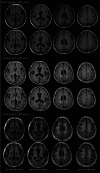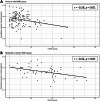Effects of strategic white matter hyperintensities of cholinergic pathways on basal forebrain volume in patients with amyloid-negative neurocognitive disorders
- PMID: 39148136
- PMCID: PMC11325579
- DOI: 10.1186/s13195-024-01536-2
Effects of strategic white matter hyperintensities of cholinergic pathways on basal forebrain volume in patients with amyloid-negative neurocognitive disorders
Abstract
Background: The cholinergic neurotransmitter system is crucial to cognitive function, with the basal forebrain (BF) being particularly susceptible to Alzheimer's disease (AD) pathology. However, the interaction of white matter hyperintensities (WMH) in cholinergic pathways and BF atrophy without amyloid pathology remains poorly understood.
Methods: We enrolled patients who underwent neuropsychological tests, magnetic resonance imaging, and 18F-florbetaben positron emission tomography due to cognitive impairment at the teaching university hospital from 2015 to 2022. Among these, we selected patients with negative amyloid scans and additionally excluded those with Parkinson's dementia that may be accompanied by BF atrophy. The WMH burden of cholinergic pathways was quantified by the Cholinergic Pathways Hyperintensities Scale (CHIPS) score, and categorized into tertile groups because the CHIPS score did not meet normal distribution. Segmentation of the BF on volumetric T1-weighted MRI was performed using FreeSurfer, then was normalized for total intracranial volume. Multivariable regression analysis was performed to investigate the association between BF volumes and CHIPS scores.
Results: A total of 187 patients were enrolled. The median CHIPS score was 12 [IQR 5.0; 24.0]. The BF volume of the highest CHIPS tertile group (mean ± SD, 3.51 ± 0.49, CHIPSt3) was significantly decreased than those of the lower CHIPS tertile groups (3.75 ± 0.53, CHIPSt2; 3.83 ± 0.53, CHIPSt1; P = 0.02). In the univariable regression analysis, factors showing significant associations with the BF volume were the CHIPSt3 group, age, female, education, diabetes mellitus, smoking, previous stroke history, periventricular WMH, and cerebral microbleeds. In multivariable regression analysis, the CHIPSt3 group (standardized beta [βstd] = -0.25, P = 0.01), female (βstd = 0.20, P = 0.04), and diabetes mellitus (βstd = -0.22, P < 0.01) showed a significant association with the BF volume. Sensitivity analyses showed a negative correlation between CHIPS score and normalized BF volume, regardless of WMH severity.
Conclusions: We identified a significant correlation between strategic WMH burden in the cholinergic pathway and BF atrophy independently of amyloid positivity and WMH severity. These results suggest a mechanism of cholinergic neuronal loss through the dying-back phenomenon and provide a rationale that strategic WMH assessment may help identify target groups that may benefit from acetylcholinesterase inhibitor treatment.
Keywords: Amyloid-negative, vascular cognitive impairment; Basal forebrain; Cholinergic pathway; Neurodegeneration; White matter hyperintensities.
© 2024. The Author(s).
Conflict of interest statement
The authors declare no competing interests.
Figures





References
MeSH terms
LinkOut - more resources
Full Text Sources
Medical
Research Materials
Miscellaneous

